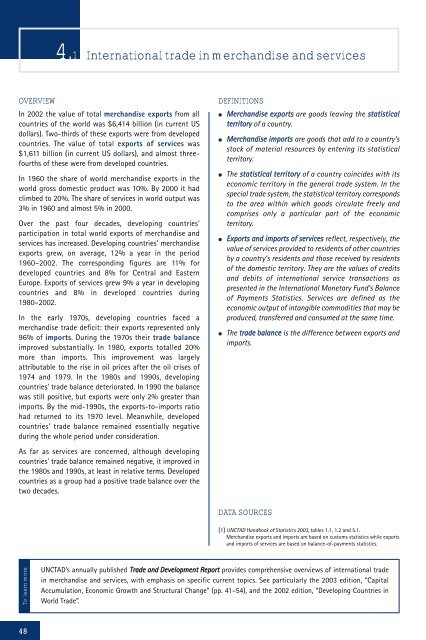Development and Globalization: - Unctad
Development and Globalization: - Unctad
Development and Globalization: - Unctad
You also want an ePaper? Increase the reach of your titles
YUMPU automatically turns print PDFs into web optimized ePapers that Google loves.
OVERVIEW DEFINITIONS<br />
In 2002 the value of total merch<strong>and</strong>ise exports from all<br />
countries of the world was $6,414 billion (in current US<br />
dollars). Two-thirds of these exports were from developed<br />
countries. The value of total exports of services was<br />
$1,611 billion (in current US dollars), <strong>and</strong> almost threefourths<br />
of these were from developed countries.<br />
In 1960 the share of world merch<strong>and</strong>ise exports in the<br />
world gross domestic product was 10%. By 2000 it had<br />
climbed to 20%. The share of services in world output was<br />
3% in 1960 <strong>and</strong> almost 5% in 2000.<br />
Over the past four decades, developing countries’<br />
participation in total world exports of merch<strong>and</strong>ise <strong>and</strong><br />
services has increased. Developing countries’ merch<strong>and</strong>ise<br />
exports grew, on average, 12% a year in the period<br />
1960–2002. The corresponding figures are 11% for<br />
developed countries <strong>and</strong> 8% for Central <strong>and</strong> Eastern<br />
Europe. Exports of services grew 9% a year in developing<br />
countries <strong>and</strong> 8% in developed countries during<br />
1980–2002.<br />
In the early 1970s, developing countries faced a<br />
merch<strong>and</strong>ise trade deficit: their exports represented only<br />
96% of imports. During the 1970s their trade balance<br />
improved substantially. In 1980, exports totalled 20%<br />
more than imports. This improvement was largely<br />
attributable to the rise in oil prices after the oil crises of<br />
1974 <strong>and</strong> 1979. In the 1980s <strong>and</strong> 1990s, developing<br />
countries’ trade balance deteriorated. In 1990 the balance<br />
was still positive, but exports were only 2% greater than<br />
imports. By the mid-1990s, the exports-to-imports ratio<br />
had returned to its 1970 level. Meanwhile, developed<br />
countries’ trade balance remained essentially negative<br />
during the whole period under consideration.<br />
As far as services are concerned, although developing<br />
countries’ trade balance remained negative, it improved in<br />
the 1980s <strong>and</strong> 1990s, at least in relative terms. Developed<br />
countries as a group had a positive trade balance over the<br />
two decades.<br />
To learn more<br />
48<br />
4.1 International trade in merch<strong>and</strong>ise <strong>and</strong> services<br />
● Merch<strong>and</strong>ise exports are goods leaving the statistical<br />
territory of a country.<br />
● Merch<strong>and</strong>ise imports are goods that add to a country’s<br />
stock of material resources by entering its statistical<br />
territory.<br />
● The statistical territory of a country coincides with its<br />
economic territory in the general trade system. In the<br />
special trade system, the statistical territory corresponds<br />
to the area within which goods circulate freely <strong>and</strong><br />
comprises only a particular part of the economic<br />
territory.<br />
● Exports <strong>and</strong> imports of services reflect, respectively, the<br />
value of services provided to residents of other countries<br />
by a country’s residents <strong>and</strong> those received by residents<br />
of the domestic territory. They are the values of credits<br />
<strong>and</strong> debits of international service transactions as<br />
presented in the International Monetary Fund’s Balance<br />
of Payments Statistics. Services are defined as the<br />
economic output of intangible commodities that may be<br />
produced, transferred <strong>and</strong> consumed at the same time.<br />
● The trade balance is the difference between exports <strong>and</strong><br />
imports.<br />
DATA SOURCES<br />
[1] UNCTAD H<strong>and</strong>book of Statistics 2003, tables 1.1, 1.2 <strong>and</strong> 5.1.<br />
Merch<strong>and</strong>ise exports <strong>and</strong> imports are based on customs statistics while exports<br />
<strong>and</strong> imports of services are based on balance-of-payments statistics.<br />
UNCTAD’s annually published Trade <strong>and</strong> <strong>Development</strong> Report provides comprehensive overviews of international trade<br />
in merch<strong>and</strong>ise <strong>and</strong> services, with emphasis on specific current topics. See particularly the 2003 edition, “Capital<br />
Accumulation, Economic Growth <strong>and</strong> Structural Change” (pp. 41–54), <strong>and</strong> the 2002 edition, “Developing Countries in<br />
World Trade”.

















